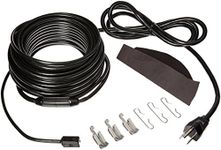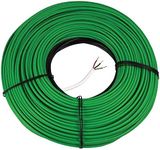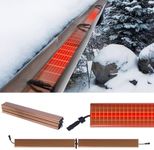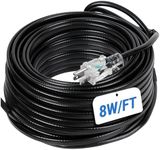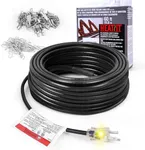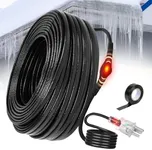Buying Guide for the Best Roof Snow Melt Cables
Roof snow melt cables are essential for preventing ice dams and heavy snow buildup on your roof, which can cause significant damage to your home. These cables are designed to heat up and melt snow and ice, ensuring that water can flow freely off your roof and into your gutters. When choosing the right roof snow melt cables, it's important to consider several key specifications to ensure they meet your needs and provide effective performance throughout the winter season.Cable LengthCable length is the total length of the snow melt cable. This is important because it determines how much area of your roof the cable can cover. To choose the right length, measure the length of the roof edge and any valleys where snow tends to accumulate. Cables come in various lengths, typically ranging from 30 feet to over 200 feet. For small roofs or specific problem areas, shorter cables may suffice, while larger roofs or multiple problem areas may require longer cables or multiple shorter ones.
WattageWattage indicates the power output of the cable, which affects how quickly and effectively it can melt snow and ice. Higher wattage cables generate more heat, making them more effective in colder climates or areas with heavy snowfall. Wattage typically ranges from 5 watts per foot to 12 watts per foot. For moderate climates with occasional snow, lower wattage cables may be sufficient. In regions with severe winters, higher wattage cables are recommended to ensure efficient melting.
VoltageVoltage refers to the electrical power required to operate the cable. Most roof snow melt cables are designed to work with standard household voltage (120V or 240V). It's important to choose a cable that matches your home's electrical system to ensure safe and efficient operation. If you're unsure about your home's voltage, consult an electrician before purchasing.
Self-Regulating vs. Constant WattageSelf-regulating cables adjust their heat output based on the surrounding temperature, becoming warmer as it gets colder and cooler as it warms up. This makes them energy-efficient and reduces the risk of overheating. Constant wattage cables, on the other hand, provide a consistent level of heat regardless of the temperature. Self-regulating cables are ideal for varying weather conditions and energy savings, while constant wattage cables may be suitable for areas with consistently cold temperatures.
Durability and Weather ResistanceDurability and weather resistance are crucial for ensuring that the cables can withstand harsh winter conditions. Look for cables with robust insulation and UV-resistant outer jackets to protect against sun exposure, moisture, and physical damage. High-quality materials will ensure the cables last for many seasons without deteriorating. If you live in an area with extreme weather, investing in durable, weather-resistant cables is essential for long-term performance.
Ease of InstallationEase of installation is an important factor, especially if you plan to install the cables yourself. Some cables come with pre-assembled kits that include clips, spacers, and detailed instructions, making the installation process straightforward. Others may require additional components or professional installation. Consider your comfort level with DIY projects and the complexity of your roof when choosing a cable. Opt for a user-friendly installation process if you prefer to handle it yourself.


